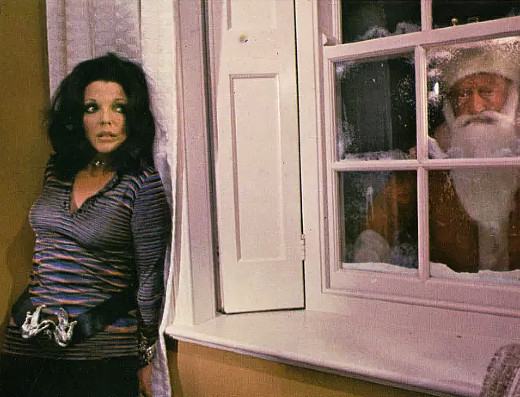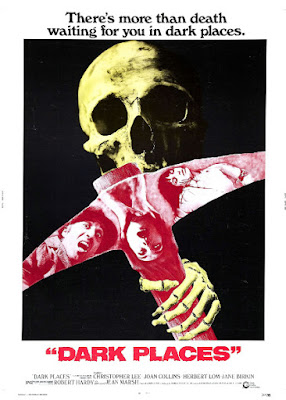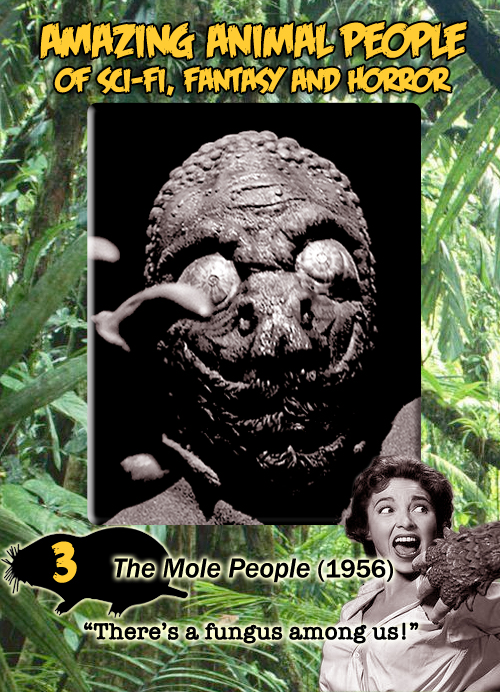Now Playing: Dark Places (1973)
Pros: Joan Collins is deliciously evil as a fortune-hunting seductress; Effective spooky atmosphere.
Cons: Christopher Lee and Herbert Lom are wasted in mundane supporting roles.
This post is part of the 2021 Joan Collins Blogathon, graciously hosted by Gill at RealWeegieMidget Reviews. Get on over to the site for a plethora of posts covering practically every aspect of Joan's career.
It’s good to be bad, at least in the movies. So many actors over the years have talked about how much they relish playing villain roles, and how much more colorful and rewarding those parts are, that it has become almost a cliché.
While there’s never been a shortage of juicy, villainous roles for male actors, women haven’t been far behind. From the man-eating vamps of the silent era to the sultry sirens of film noir to today’s female action badasses, fem fatales have always done well at the box office.
Actresses like Joan Crawford and Bette Davis became Hollywood icons chewing up men and spitting them out on the silver screen, and when the glamour roles dried up, they went right on being as bad as can be in B movies.
That career trajectory has played out many times, but few actresses have embraced it with as much panache as Joan Collins. Glamour has always been her trademark, but being dark haired and British, it was perhaps inevitable that she would be steered into fem fatale roles. Lucky for her, and us. If she’d been any sweeter, we’d be asking “Joan who?”
Collins’ bad girl image got an early boost with her role as the nefarious Princess Nellifer in the lush costume epic Land of the Pharaohs (1955). As Nellifer, she lies, cheats, steals and hires out assassins as she schemes to acquire Pharaoh Khufu’s (Jack Hawkins) wealth and power -- and she looks absolutely fabulous doing so.
 |
| "Hey Jack, have you been stealing from my wardrobe again?" |
Several years later, she tested for the title role in the even more epic film Cleopatra, but lost out to Elizabeth Taylor. Collins almost got the part anyway, when Taylor became so ill during production that it looked like she wouldn’t be able to continue. Collins’ agent told her to get packed and be ready to report to the set at any moment. [Joan Collins, Past Imperfect, Simon & Schuster, 1984, p. 191]
Of course, Liz recovered. Would Collins still have become the premier go-to villainess after playing Cleopatra, or would her career have taken a different path? We’ll never know, but that’s all right -- the path she traveled in this particular universe is fascinating enough.
On her way to the ultimate glamorous and venomous role -- Alexis Carrington Colby on the ‘80s primetime soap Dynasty -- Collins took a detour into B horror-thriller territory in the early to mid ‘70s.
The horror roles came in quick succession, starting with Amicus’ wildly popular Tales from the Crypt anthology film in 1972. As befitting the future Alexis, she was no shrinking (or shrieking) violet to be easily taken out by the monster. In many of them, she was the monster (although a very alluring human one).
In Tales from the Crypt, she kills her husband on Christmas Eve and gets the bright idea to blame it on an escaped mental patient who is loose in the neighborhood. In the Hammer thriller Fear in the Night (1972), she is the cold, calculating wife of a school headmaster, lurking in the background while one of the school’s new employees (Judy Geeson) is repeatedly attacked by a mysterious figure. In Tales that Witness Madness (1973), she battles an uncanny, sentient tree (!) in a desperate attempt to save her marriage. And in I Don't Want to be Born (aka Sharon’s Baby, 1975), she gives birth to a demonic baby.
 |
| Joan realizes she's on Santa's naughty list in Tales from the Crypt (1972) |
Which brings us to the main attraction, Dark Places (1973), a fitting description of where Collins’ career was taking her at the time. Although independently produced, Dark Places greatly resembles the psycho-mystery-thrillers scripted by Jimmy Sangster for Hammer during the ‘60s and ‘70s (Scream of Fear, Paranoiac, Hysteria and Fear in the Night among them).
In this case, the writing team of Ed Brennan and Joseph Van Winkle place a mild-mannered hospital administrator, Edward Foster (Robert Hardy) at the center of ominous events.
Foster is the last person to visit with Andrew Marr -- formerly a wealthy country squire -- before Marr’s death in an insane asylum. Marr had been committed years ago after a psychotic breakdown caused by the sudden disappearance of his wife, two children, and the children's governess.
Foster learns that Marr bequeathed his sprawling estate to him in gratitude for his companionship. He moves to the nearby village and begins to pick through the ruins of the ramshackle old house, aware of the rumors that the squire stashed a fortune in cash somewhere on the grounds.
Foster suddenly acquires new friends: Dr. Mandeville (Christopher Lee) and his sister Sarah (Collins), and the village solicitor, Prescott (Herbert Lom). The three, also aware of the hidden loot, attach themselves like leeches to Foster, suspicious that Marr told him of the money’s location before dying.
 |
| Sarah cases the joint. |
Sarah goes into high vamp mode, shamelessly flattering the unfashionable, middle-aged man: “You’re much younger than I expected. Most of the men in this village are past it. It will be nice to have somebody younger.”
She offers to help him clean the place up, the better to keep an eye out for satchels of cash. Later, as she’s scheming with her brother, she positively purrs with mischievous contentment:
Sarah: “He’s nice, isn’t he?
Mandeville: “Can’t you keep your hands off anyone?”
Sarah: “He’d be quite attractive with £200,000, quite eligible.”
Mandeville: “You are a bitch Sarah.”
As Foster’s newfound friends conspire to get their grubby hands on the money, they are blissfully unaware that the spooky old house is having a profound effect, making the uptight, skittish man far more dangerous than outward appearances would suggest.
 |
| Dr. Mandeville (Christopher Lee) is concerned for his sister's moral welfare. |
As you might expect, Collins gets all the best lines, and you can’t take your eyes off her as she exudes pure, mercenary evil. On the other hand, Christopher Lee and Herbert Lom are given little more to do than stand around with concerned frowns on their faces. Fans at the time might have been excited by ads trumpeting the names Collins, Lee and Lom, but the film belongs to Collins and the lesser-known character actor Robert Hardy.
Some fans and critics have disparaged Dark Places for building the film around the nondescript Hardy rather than one of the horror icons, but the story benefits from a mild-mannered everyman at the center of the action, the better to make the character’s transformation all the more dramatic.
Dark Places sets up an effectively spooky atmosphere that slowly builds in suspense as Foster putters around the mansion, encountering lights that shouldn’t be on, creepy dolls with smashed faces lying on the floor, hobby horses rocking themselves, and eerie voices and children’s laughter echoing through the halls.
Foster becomes a man doubly possessed: possessed by the idea of finding the hidden fortune, and possessed by Marr’s overpowering spirit to the point that he begins reliving the squire’s tragic past.
 |
| Edward (Robert Hardy) wonders why he suddenly has so many friends. |
Even as Sarah tries to seduce and manipulate Foster, Foster/Marr pursues his lost love -- the governess Alta (Jane Birkin) -- through the misty past. Unbeknownst to Sarah, who is blinded by greed and pride in her ability to reduce men to putty, the past will quickly catch up to the present, and tragedy will repeat itself with a vengeance.
Robert Hardy was an extremely versatile and busy character actor who appeared in scores of mostly British TV series and movies over the course of seven decades. His portrayal of Winston Churchill was apparently so spot on that he was called on to play the politician in three separate productions in the 1980s, including the highly regarded TV mini-series War and Remembrance. He also appeared as Minister of Magic Cornelius Fudge in several of the Harry Potter movies.
Hardy as the befuddled Foster is the perfect foil for Collins the man-eater. He seems perfectly harmless -- right up until he’s not.
Director Don Sharp helmed several Hammer horror films and thrillers in the 1960s, including The Kiss of the Vampire (1963), The Devil-Ship Pirates (1964) and Rasputin: The Mad Monk (1966). Other horror credits include Witchcraft (1964, with Lon Chaney, Jr.), Curse of the Fly (1964), two Fu Manchu movies with Christopher Lee, The Face of and The Brides of (1965 and 1966, respectively), and the cult favorite Psychomania (aka The Death Wheelers, 1973).
Sharp’s genre movie experience, plus a cast of talented veteran actors (especially Collins as a slinky man-eater), plus a script that allows the eeriness to build slowly but surely, adds up to a surprisingly good psycho-supernatural-mystery-thriller.
Where to find it: Unfortunately, Dark Place's home video releases are out-of-print. Currently there is a watchable (but not great) copy streaming on YouTube.
 |
| Edward has a pickaxe to grind. |
Extra! Dame Joan Collins’ real-life encounter with the supernatural!
In doing some background digging for this review, I was surprised to find out that Joan’s experience with things that go bump in the night was not confined solely to the movies.
In a season two episode of the TV show Celebrity Ghost Stories, Collins describes an after-dinner party she attended in an old Venetian palazzo that was interrupted by an angry poltergeist. Guests were startled to find the outline of a body laid out on the dining room floor with almond candies. The butler told the guests that the outline was in the exact spot where a young wife had been murdered by her husband years before.
Then, in quick succession, a large knife flew across the room and stuck itself in the wall, and a large urn propelled itself across the floor. Everyone scattered, and Collins was convinced it was the ghost of the murder victim warning people away from the place where her life was prematurely cut short. See the clip here.




























